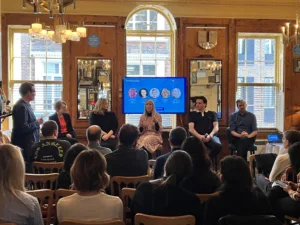Until recently, it seemed that every passing year was declared the ‘year of mobile’ by digital marketers, so what’s the state of play with mobile marketing in 2022? New Digital Age (NDA) recently gathered a panel of industry experts to discuss this question in detail and provide an up-to-date snapshot of the mobile marketing ecosystem.
NDA’s editor-in-chief Justin Pearse hosted the session, where he was joined by: Dave Wallace, Head of Consumer Apps at Mediacom; Annabelle Rogers, Head of Paid Social and Display at VCCP Media; Saint Betteridge, Chief Commercial Officer at Picnic; Barry Walsh, Digital Strategy Partner at Havas Media Group; Josh Williams, Head of Technology at Mediahub; and Paul Coggins, CEO of Adludio.
Mediacom’s Dave Wallace opened the discussion by highlighting the increased level of client interest in ‘app experience’. Wallace said: “Not so long ago, apps were on the periphery of the mobile ecosystem but, today, we’re seeing more clients than ever using apps as a priority element of their overall brand experience and exploring the marketing opportunities that apps can provide. We’re seeing more clients get the basics right, with things like ‘magic links’ being used more effectively to generate sales.
“We’re challenging our clients to think about everything from customer acquisition through to retention, and asking where their app sits within all of that. The biggest issue we’re encountering is the traditional silos that still exist in big businesses. Historically, brand apps and mobile experiences have ended up the responsibility of digital and IT teams, which can be a problem when marketers need to move quickly to capitalise on a business opportunity or fix customer experience issues.”
Annabelle Rogers of VCCP Media mentioned the increased popularity of TikTok as a marketing channel and placed social media more generally at the heart of the mobile marketing debate.
She said: “You can’t really talk about mobile right now, without talking about social media, as most mobile spend at the moment is going through social channels. Inherent to that is apps and app strategy. I agree that the silos within many organisations, including agencies themselves, mean there’s a lack of holistic vision in relation to mobile, encompassing social, search, PPC, open web display, apps and UX.
“For example, what kind of user experience are consumers getting on the open web on mobile browsers? In a lot of cases, it’s a poor, disruptive experience, with pop-ups going off all over the place, which feeds into why people like apps so much. They’re customizable, and you can create a very bespoke customer experience and an environment where advertising can seem a lot more ‘native’. I think ad tech players, agencies and publishers all have a collective responsibility to improve the mobile user experience.”
Mobile experience
Saint Betteridge of Picnic agreed that social media platforms and apps such as TikTok have raised the expectations of mobile users in relation to user experience. He said: “From a user perspective, it doesn’t really matter whether they are viewing an app or a mobile web page, they expect the same levels of performance and experience that they get from their favourite social platforms. We’re seeing increased creativity and innovation around ad formats, with partners working to boost interactivity and drive dwell time. Mobile will also have a role to play in the renewed focus on contextual advertising, but you’ve got to be delivering a best-in-class, people-first experience or you are out of the game.”
Barry Walsh of Havas Media Group discussed how the smartphone’s central position in our lives makes it more important than ever for brands to leverage the power of mobile marketing.
He said: “In 2022, your phone is like a remote control for your whole world. It connects to your Ring doorbell, your Hive metre, it connects to your car, your bank accounts, the list goes on. I rarely carry a wallet anymore – I just tap my phone. What’s more, the pandemic opened up things like shopping via a smartphone to a whole older generation who probably wouldn’t have considered it before.
“I’ve worked with a number of different verticals – such as publishers, retailers and luxury goods providers – and without exception, mobile experience has positively impacted their bottom line. That means that it’s now a minimum requirement for big brands to deliver a great mobile experience. A recent study suggests that 26% of all online purchases are abandoned if the checkout process is too long. The problem is that some brands are just behemoths and can only focus on so many things at one time. Unfortunately, mobile user experience isn’t always at the top of their priority list.”
Mobile attention
Mediahub’s Josh Williams argued that those brands with a clear point of view on the purpose of an app within their business model are the ones having most success via mobile. He said: “What’s the purpose of your mobile app? Is it complimentary or fundamental to your business? For example, an online only financial services business, it’s fundamental. For a home decorating supplier like Dulux, an app might allow customers to paint their house different colours via augmented reality, with the goal of driving in-store footfall and paint sales. Mobile is driving outcomes at all stages of the marketing funnel. What’s really interesting at the moment is that, at a broad level across a range of clients, mobile is driving high levels of attention. Mediahub’s global attention platform ARC shows mobile driving 2x more eyegaze attention compared to desktop”.
Paul Coggins of Adludio agreed all current indications suggest that mobile will remain a core element of marketing plans for the foreseeable future, while other fashionable formats may fall quickly out of favour.
Coggins said: “I read an article on the BBC new site today describing how there’s a growing movement to ban digital out of home advertising completely, due to its potential impacts on children. In fact, some cities in the world have already banned it. That will never happen with mobile simply because it’s the individual’s own device.
From an advertisers perspective, it’s much more personal, you can hit the right audience with the right metrics, even in light of the various data privacy restrictions that are coming in. Mobile marketing today is less about tracking people relentlessly around the web and more about creativity, interactivity and engagement. “









